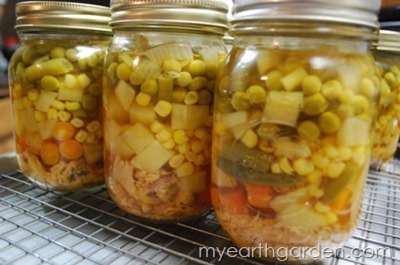Home canning is enjoying a well-deserved resurgence in recent years, and that leaves a lot of people looking for information on how to can and preserve food at home.
While there are foods that can be canned using the fairly basic water bath method, when it comes to recipes that contain low acid foods, meat, fish and poultry, pressure canning is a must. Unfortunately many of us (myself included) have either heard or experienced horror stories firsthand that involve pressure cooking, leaving us unnecessarily fearful of using a pressure cooker to preserve food.
A few days ago through my Facebook page I came across a link from the Canning Granny group that was the simplest and most basic recipe for home canned chicken and vegetable soup I’d ever seen. As we had not yet canned any soup this year I wanted to seize the opportunity to give it a shot and show My Earth Garden readers just how simple it really is to can chicken soup at home.
The Recipe
The recipe can be found here. As you will note it is a very basic and no nonsense framework-type recipe typical of what my own granny would have done. It suggests amounts, leaves off seasonings entirely and allows plenty of wiggle room for adjusting the types of vegetables you want. Just a few base ingredients are a platform for creating a chicken and vegetable soup that is perfectly-tailored to your taste.

In the photo above you can see the ingredients for our soup ready to be canned. Clockwise from top right: pre-cooked chicken, frozen sweet peas, frozen green beans, frozen whole kernel corn, diced carrots, diced potatoes and chicken broth (center). Not pictured: diced onion. We added peas to the original recipe for personal taste. I also added a bit of salt and black pepper to each jar.

Here you see all of the ingredients layered in pint jars. The next step was to fill the jars with warm chicken broth, wipe the rims clean, then put on lids and rings.
Per the instructions, we processed the pints in a pressure canner at 10 lbs. of pressure for 70 minutes.

After 70 minutes, we turn off the heat and allow the pressure to reduce on its own before removing the canned soup to a cooling rack.
Here you see the finished jars as they cool, a process that will take quite a while considering the high heat and pressure they have been under.
Aside from the satisfaction of knowing every ingredient that goes into your food, canning chicken soup into pint jars like this makes perfect sense from a convenience standpoint as well. A quick meal is as easy as opening a jar and reheating on the stove or in the microwave, making it a great option for taking your lunch to work.
Because we didn’t prepare this recipe when our gardens were in full harvest, we had to purchase some of the veggies frozen. Still, the total ended up being about $10 for 15 pints of homemade soup. The cost will be far less when we raise our own chickens and use fresh vegetables from the garden.
I should mention that each pint contains 1.5 ounces of chicken which is easily more than you would find in most any commercially produced soup. You try finding such a high quality chicken and vegetable soup without additives and preservatives for $.67 a serving.
Now if you’ll excuse me, it’s time for lunch.

Special thanks to Pamela at Canning Granny for the recipe.


How long will they stay good for?
As with anything home canned, it will depend on a lot of variables. I can only say that in my own experience, I have opened a jar over a year later and had absolutely no issues.
Can I use old Classico spaghetti sauce jars?!?! Everything looks so perfect.
Have you used old maya on jars? Or new each time???!
HELP!?!?!!! Poor and want to can tomatoes from the garden.
When it comes to home canning, safety is critical. You can’t use old jars and be guaranteed that they will be safe. Canning jars must have lids and rings that are clean and in good condition to ensure bacteria can’t get in once the jar has sealed, and to ensure that the seal holds. For more information on canning safety, please visit the National Center for Home Food Preservation website at http://nchfp.uga.edu/index.html.